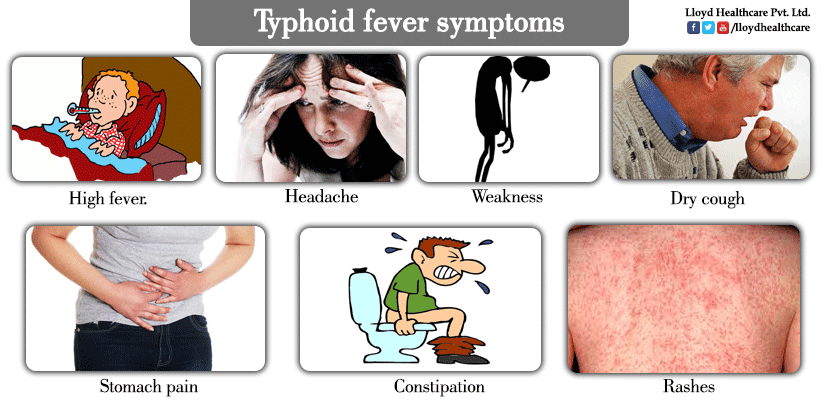Typhoid fever is an infectious disease caused by bacteria salmonella typhi, which can lead to the appearance of some symptoms, such as high fever, lack of appetite, dry cough, chills, enlargement of the spleen and red spots on the skin.
Typhoid fever is related to low socioeconomic levels, especially with poor sanitation and personal hygiene conditions and, therefore, the transmission of this disease occurs mainly through the consumption of contaminated water and food.
It is important that the treatment for typhoid fever is done as soon as the first signs and symptoms of the disease are identified, as this way it is possible to prevent complications of the disease, such as abdominal bleeding, bowel perforation or generalized infection, for example. Thus, it is recommended that the person remains at rest, drink plenty of fluids and use antibiotics in accordance with medical advice.
typhoid fever symptoms
The initial symptoms of typhoid fever are mild, as the bacteria can take between 1 to 3 weeks to multiply and lead to the development of more noticeable and more serious signs and symptoms. The main symptoms indicative of typhoid fever are:
- High fever;
- Chills;
- Dry cough;
- Stomach ache;
- Constipation or diarrhea;
- Vomiting;
- Headache;
- General malaise;
- Enlarged spleen and liver;
- Loss of appetite;
- Dry cough;
- Change in heart rate;
- Reddish spots on the skin, especially on the chest and abdomen.
It is important that typhoid fever is identified and treated soon afterwards, as this can prevent the development of complications that can be life-threatening, such as abdominal bleeding, bowel perforation and generalized infection.
How is the diagnosis made
The diagnosis of typhoid fever is made by the general practitioner or infectologist based on the evaluation of the signs and symptoms presented by the person, in addition to taking into account the person’s life and hygiene habits.
In addition, blood, feces and urine tests are performed to identify changes in the tests suggestive of infection by the bacteria. In addition, microbiological tests may be requested, such as stool culture and blood culture in order to identify the presence of salmonella typhi and, thus, it is possible to confirm the diagnosis and initiate the most appropriate treatment.
how the transmission happens
The transmission of the bacteria responsible for typhoid fever happens mainly through the consumption of water and food contaminated by urine or feces containing the bacteria. The main foods related to the transmission of thyroid fever are unpasteurized milk, seafood, vegetables, legumes, vegetables and unwashed fruits.
Furthermore, it is possible for the disease to be transmitted when it comes into contact with the hands or secretions of a person with the disease.
how is the treatment
Typically, treatment for typhoid fever can be done at home with the administration of prescribed antibiotics such as chloramphenicol for about 14 days. In case of resistance of the salmonella typhi to Chloramphenicol, the doctor may recommend other antibiotics such as Ampicillin, Sulfamethoxazole-Trimethoprim, Amoxicillin, Ciprofloxacin or Ceftriaxone, for example. It is important that the treatment with antibiotics is carried out according to medical advice, even if there are no more apparent signs or symptoms, as this way it is possible to guarantee the elimination of the bacteria.
It is also recommended that the person remain at rest and have a light diet low in calories and fat and fluid intake for the patient to stay hydrated. In more serious cases, it may be necessary for the individual to be hospitalized to be monitored and receive serum and antibiotics through the vein.
It is advisable to drink plenty of filtered water or tea to stay hydrated, avoid foods high in fat and sugar. To reduce fever, several baths can be taken throughout the day, in addition to taking paracetamol or dipyrone at the recommended times. You should not take laxatives to loosen the bowel or consume foods that bind the bowel in case of diarrhea.
Usually after the 5th day of antibiotic treatment, the person no longer shows symptoms of the disease, however it is important that treatment is continued as directed by the doctor, since the bacteria can remain in the body for about 4 months without cause symptom.
Typhoid Fever Prevention
Recommendations for typhoid fever, which should be followed to prevent typhoid fever and also during treatment, include:
- Wash hands before and after using the bathroom, before meals and preparing food;
- Boil or filter water before drinking it;
- Do not consume undercooked or raw foods;
- Prefer cooked food;
- Avoid eating away from home;
- Avoid going to places with poor sanitary and hygiene conditions;
- Do not let the child accept food from strangers or drink water from drinking fountains at school;
- Warn and do not let the child put objects in the mouth because they may be contaminated;
- Set aside a bottle of mineral water or boiled or filtered water just for the child.
In addition, to prevent the development of typhoid fever, the vaccine for typhoid fever can also be recommended, which is mainly indicated for people who live in or will travel to places with a high prevalence of this disease.
